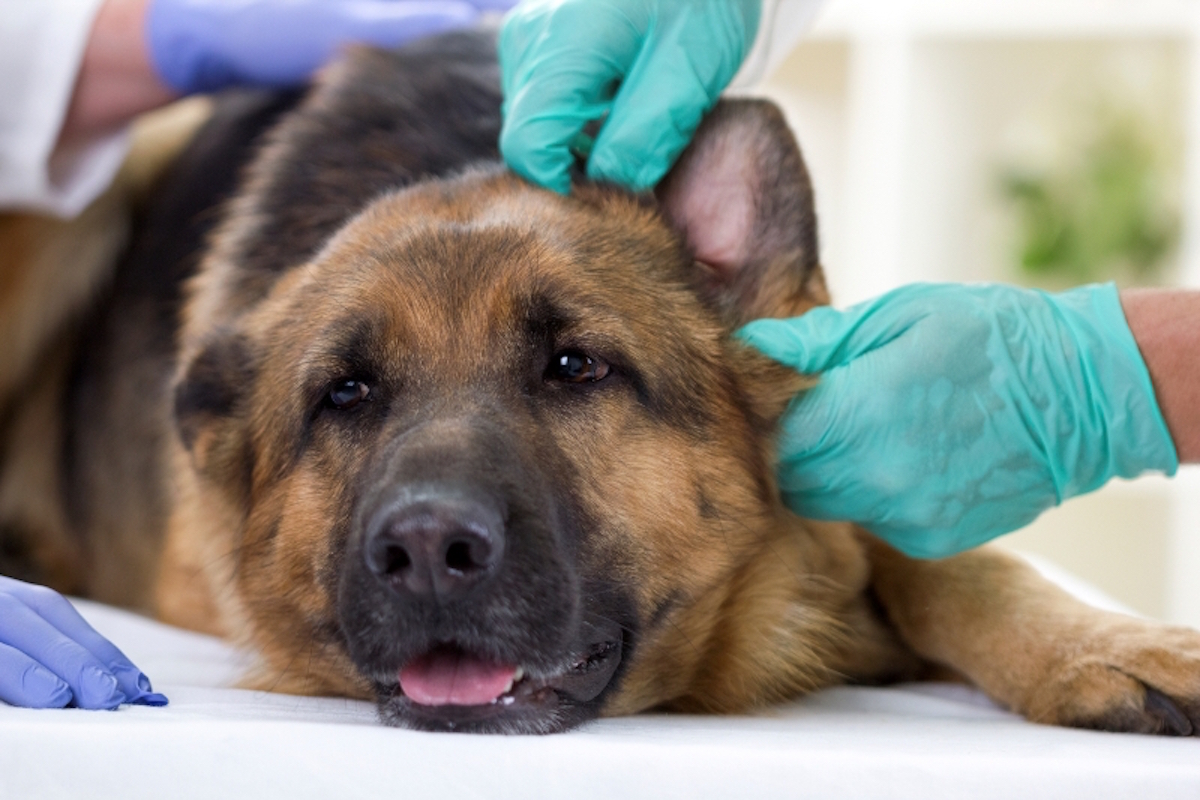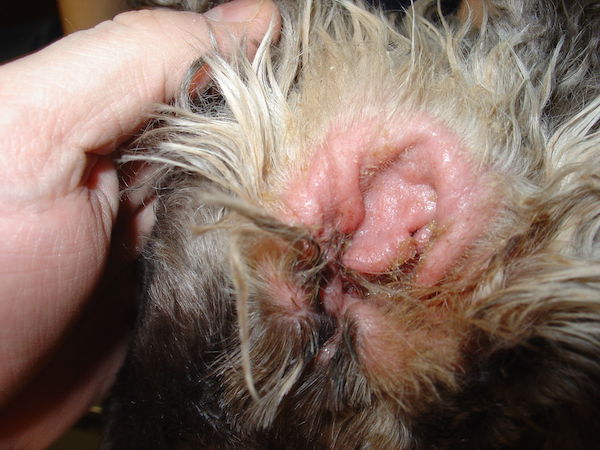Did you know that ear infections are one of the most common reasons that pet parents take their dogs to veterinarians? They not only cause your dog discomfort, but they also can can lead to permanent hearing loss if they are left untreated. That’s why checking and cleaning your dog’s ears regularly is a key part of keeping your dog healthy.
Most ear ailments in dogs are caused by moisture, allergies, foreign objects and parasites. Dogs get bacterial, fungal or viral infections, microscopic ear mites, fleas, ticks, debris and foreign bodies in their ears, all of which can endanger your dog’s health and hearing.
Dogs have long ear canals that hold water after they have had a bath, a swim or are exposed to water. That’s why yeast infections are most common type of ear infection in dogs, as the yeast thrives on moisture. Dogs that spend a lot of time in the water (like sporting breeds) or dogs with long, floppy ears like Beagles and Spaniels, will tend to be more prone to getting ear infections.
The canine ear is made up of the external ear, the middle ear and the inner ear. Each of these anatomical parts can become inflamed, irritated or infected, causing distinct symptoms which are referred to medically as “otitis” (e.g. otitis externa) which means inflammation of the ear.
Diagram of a dog’s ear. Wikimedia
Common Symptoms of Ear Problems
Healthy canine ears are clean, odor-free, pale pink in color and minimal accumulation of wax. But if your dog evinces any of these behaviors they could have an ear infection:
- Hyper-sensitivity to ears being touched
- Repeatedly shaking their head
- Intense rubbing their face, scratching at their ears
- Constant head tilting
- Hearing loss (does not respond to sounds normally)
- They might also whine, pace or even stop eating because of the irritation
Severe otitis externa in a four year old Cocker Spaniel. Wikimedia.
If you look inside the ear and notice any of the following problems, contact your veterinarian:
- The inside of the ear appears red, irritated or swollen
- There’s a bad, pungent smell
- Discharge or blood coming from ear
- Abnormal waxy build up (brown or black ear wax or ear wax that is dry and looks like coffee grounds are signs of possible ear mite infestation)
- Abnormal lumps or bumps
- Cuts and abrasions
- Crusty or flakey skin
- Thickening (hyperplasia) of the ear flaps
Common Causes of Ear Ailments and How to Prevent Them
Moisture: Moisture inside the ear can cause yeast and bacterial infections, so it is important if your dog gets their ears wet that you ensure they are dried as much as possible. Keeping your dog’s inner ear dry is key to preventing ear infections. The best way to do this is to use an acidic cleaning solution to flush your dog’s ear. These products can be purchased from your veterinarian or pet store. By simply squirting a little in, swishing it around and then using a cotton ball to gently soak out the dirt, you can help prevent infection.
DO NOT scrub or jam the cotton balls too deeply in your dog’s ears as they are very fragile! And NEVER use alcohol or Q-tips to clean your dog’s ears. Alcohol will irritate your dog’s skin and may cause an allergic reaction and Q-tips can damage a dog’s ear drums and force debris and foreign objects further down the ear canal.
If your dog already has an ear infection, always consult your vet. Veterinarians will likely prescribe antibiotics for bacterial infections and antifungals for yeast / fungal infections. Please note that untreated ear infections can lead to more serious problems and can cost your dog his hearing.
Allergies: Allergies, such as food allergies, can also cause ear problems. Dogs commonly shake their head or constantly scratch their ears if they have an allergic reaction, in order to try and relieve the swelling and itchiness. Sensitive ear tissue can be damaged by frequent head-shaking and dog’s can scratch themselves until they bleed, so continual scratching and head shaking should not be ignored.
Foreign Objects: Dirt and plant debris are the most common elements that enter a dog’s ears. If the debris makes its way down the ear canal it can cause an infection. Also, if foreign objects travel down the ear canal, the could cause perforations to the ear drum and other internal damage to an ear. In the case of certain foxtail grasses, the sharp seed awns can cause serious damage.
Fleas, ticks and microscopic ear mites: These common parasites can cause ear problems. Ticks also like to latch on to dog’s ears for the easy blood supply. These parasites will often leave tell-tale signs. Fleas leave dried blood that looks like pepper flecks. Ear mites leave black/brown debris that look like coffee grounds. Ticks will look like small smooth lumps attached to your dog’s ear or lumps if they have burrowed under the skin.
How to Clean Your Dog’s Ears
Always consult with your veterinarian first before using any ear cleaning product or home-made solution to ensure you are cleaning your dog’s ears appropriately and safely.
- Find a comfortable place to sit with your dog. Have the cotton balls (or gauze) and cleaning solution ready.
- Gently flip your dog’s ear over so you expose your dog’s ear opening.
- Use the cotton swab with cleaner solution on it and gently wipe away any debris and ear wax.
- Wipe all around the top inside area the ear that you can see. Do not clean areas down the ear canal.
- Use a fresh piece of gauze or cotton ball on the other ear.
- If you notice any inflammation, bad odor, swelling or any other abnormality do not clean the ear. Instead consult your veterinarian.
The following video demonstrates this cleaning technique, as well as how to do a deeper cleaning (ear flush), which is important to removing moisture from the inner ear.
Please share this information with the pet lovers you know and keep your dog healthy and happy!
















Pat Ellis
- Edit
Donna Fry
Robert Miller
- Edit
Will Miller
Christopher James Cooper
- Edit
Laura Cooper
Laura Cooper
- Edit
Best get down the vets!! ☹️
Jean Hunter
- Edit
Ko
Philip Richardson
- Edit
Phil Jones – might be useful?
Yasmin Completo Nuñez
- Edit
Simon Nuñez
Helen Dunlap
- Edit
I use a mixture 1/2 and 1/2 of white vinegar and witch hazel.
James King
- Edit
Frankie King